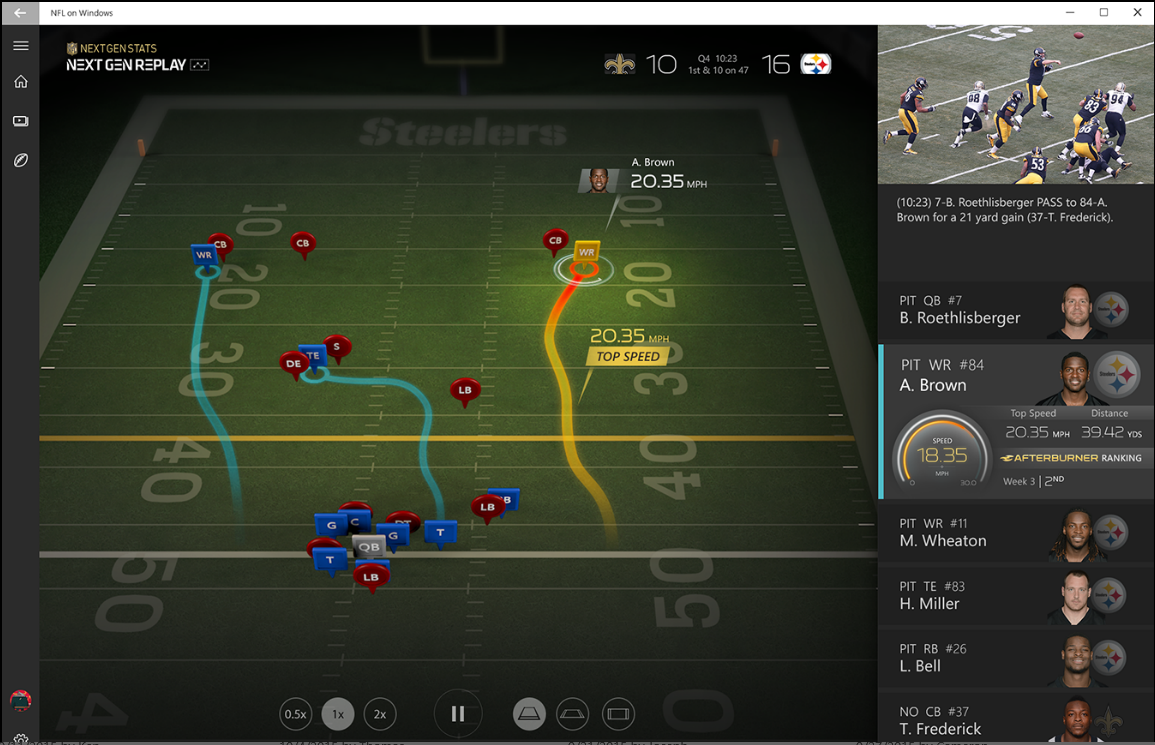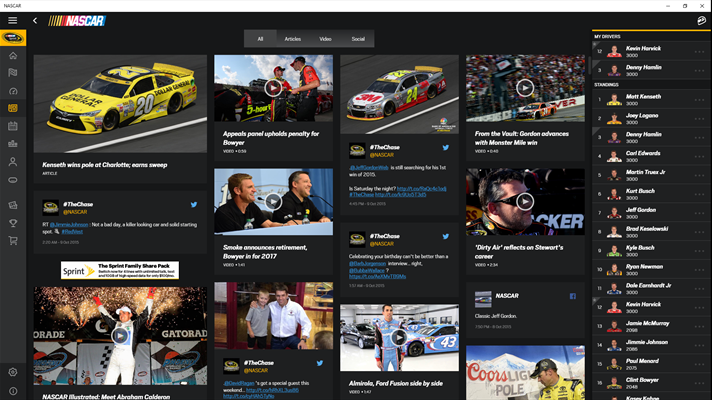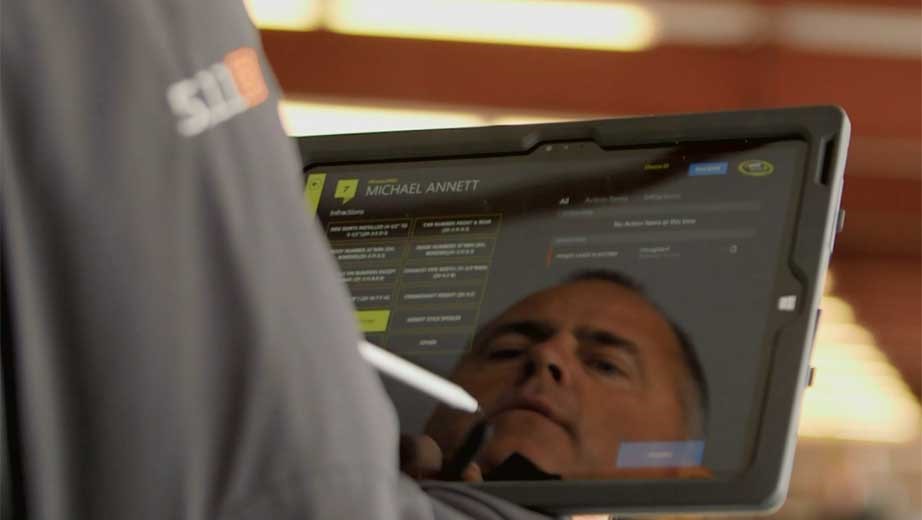Transforming Sports with Technology
The world of sports is changing – not along the lines we are used to, like rule changes, or the increase in athletic prowess – but rather advancements of technology related to sports are driving a complete re-thinking of all aspects of the business.
Every industry today lives at the crossroads of transformation and disruption. Back in July at Microsoft’s Worldwide Partner Conference, I kicked off a conversation with partners regarding this disruption using the dairy industry as my example, and on Monday at DEVintersection I gave a similar pitch to the developer community. Today I had the pleasure of being invited by the Sports Business Daily to speak to a large collection of sports industry influencers about the effect of technology upon sports.
Sports is one of those incredible industries where we can see the best of transformation and disruption, (from the athlete, to the team/league, to the fan), all going on in a dramatic and visible fashion. The rapid pace of change assures that we will continue to see more activity in this area. Just today we announced an agreement with the PGA TOUR where we’ll create new and unexpected ways for fans, players and broadcast commentators to engage with the TOUR on any digital device.
In sports, where technology and business model changes are accelerating, finding an opportunity to transform or disrupt – a competitor, the industry, or even your own team/league – is critical. For example, NASCAR is transforming its business with immersive fan experiences available through its apps, putting fans right in the car, live on race day. Beyond the fans, NASCAR has also taken its race preparations to the next level with cloud connected applications in the pits, cutting inspection times from six to two hours, and empowering infraction tracking that didn’t previously exist. The ability to deliver content, share data, and generate insights is dramatically accelerating NASCAR’s business both on and off the track.
For Real Madrid, being the #1 sports franchise in the world with 400M fans is a great accomplishment. With this number of fans distributed across the globe, engaging, gathering data, and generating insights presents both challenges and opportunities on a massive scale. Real Madrid has been proactive in transforming the way it’s engaging fans globally – allowing the club to tailor experiences, offers, and content for different geographies and fans, as well as working to transform the in-stadium experience for the lucky ones who get to watch the game in-person.
A new generation of ISVs are emerging as this change occurs. They are targeting the Sports Industry and bringing disruption into the mix. This includes companies like OpenField, who is innovating aggressively in building smart stadium experiences. From the Internet of Things side, Sensoria, Recon Instruments, X2 Biosystems and Zepp are using sensors and data capture to change the way that athletes train. Then there is freeD, who are evolving the way we view sporting events through the use of multiple 2D camera angles to create immersive 3D experiences.
Let’s look at Zebra as an example. They’ve worked with the NFL to put sensors on NFL players, and they are surfacing interesting data and data visualizations to fans in real-time through the NFL’s apps for XBOX One and Windows 10. The opportunities to consume information have never been richer, and this information has differing value to the athlete, the team, and the fan. Users can see visualizations ranging from the routes run by your favorite wide-receiver illustrated in real time, to seeing the g-forces applied when he makes his break. Take a look here for more…
Find the NFL on Windows app for Windows 10 here…
The Opportunity for Sports
In the realm of sports, the power of data to drive transformation is nearly immediate. The reason is straightforward – few industries are as meticulously analyzed as sports. The inherent understanding, rigor, and methodologies for analyzing data are already in place. From the NFL scouting combine, where athlete performance data is gathered, transformed and analyzed, to auto racings’ myriad of sensors and instrumentation sending real-time data back to pit crews – the sports industry has been built upon using data to calculate an advantage.
Today, the sophistication of technology at each step has amplified the opportunity for gathering, understanding, and applying data. Never before has so much information been readily available.
Collecting data no longer requires a hand and a stopwatch; wearables provide a constant stream of data from the athletes, powerful sensors determine the difference in force from one hit to the next, and all that data is available instantly. From RFID tracking, to biometrics, accelerometers, position tracking, yaw tracking, and countless other metrics, we now have instant access to a broad set of up-to-the-minute data that can be applied for rich analysis in real-time and in review.
It is important that you remember that a single data point in isolation is rarely effective at driving insights. To illustrate, think about taking your temperature when you aren’t feeling well. If you have a fever, that’s a great indicator that something is wrong, but the temperature alone doesn’t indicate the underlying illness. You need observations of other symptoms (data) for analysis, so that someone with the right skills can generate insights from this data. While chicken soup can’t hurt, a treatment plan specific to your condition can accelerate improvement.
The same holds true for sports. The power of technology enables sports data to be quickly gathered, analyzed, and turned into useful insights. These insights can then be applied to solve for a number of scenarios, including improving the fan experience, increasing competitive advantage, or improving business outcomes.
For Fans
We’ve already talked about Zebra – their impact on enhancing the fan experience is pretty exciting. In the same vein, another example is NASCAR. With their latest app, NASCAR has given fans the opportunity to get into the car with their favorite drivers. On race days, there is an Interactive Chase Grid, live leaderboards for all NASCAR Series, lap-by-lap commentary, real-time news and video, and extensive driver data, news, and social media feeds.
With premium features, the idea of “immersion” is taken to a new level. There’s a Premium Live Leaderboard, that allows fans to track their favorite drivers on a customized leaderboard with all new data points. There’s Live Driver Audio, where fans can listen to the in-race strategy between drivers, crew chiefs, and spotters. There are also feeds where fans can watch live in-car cameras for the entire 2015 NASCAR Sprint Cup Series season, as well as live Broadcast Radio and Officials’ Radio.
For Competition
Air Racing is a sport where one second can mean the difference between a good day and a bad day. This sport is comprised of a series of high-speed, low-altitude airplane races in which pilots compete to be the first to make it through a series of gates. A typical trip through the course is over in less than 90 seconds, and when reaching speeds as high as 230 miles an hour it’s not uncommon for finalists’ times to be within a half-second of one another.
Using data acquisition and analytics a Red Bull Air Race pilot now has an advantage in this race against time. Technology developed at Microsoft Research now computes the most efficient path through each course by optimizing speed by location, as well as turn radius, impact of prevailing winds, and numerous other factors. Finding the perfect balance between those factors equals an advantage in this daring race.
Outside of Air Racing, these calculations show promise in helping commercial pilots and others in the aviation industry find more efficient flight paths, potentially benefiting an industry operating on already-thin margins.
For Business
We return to NASCAR, where they aren’t just focusing in one area but are driving significant innovation in regard to the business of racing. Partnering with Microsoft, NASCAR was able to streamline the labor-intensive process for on-site technical inspection, trimming nearly half the time spent examining cars and recording pertinent data.
Before the inspection app, 60+ officials would spend 5-6 hours inspecting the cars through 8 stages of inspection. Officials would initial off 2000 items each weekend on paper for 38 weekends in the year, which meant there was no accurate way to track vehicle progress – everything was captured on paper. No trending data analysis was possible in regard to infractions, which impacted consistency.
After the introduction of the app total inspection time was cut in half – now the process takes just over 2 hours to complete. Today officials logging their inspection findings and clearance right into the app which synchs data into a master database for real-time and future analysis. The app now makes it easy to track a vehicle’s progress through the inspection process, as gives officials visibility into infractions (if any) given at each station. The availability of past inspection data now makes it easy for officials to spot trends with specific race teams and/or the entire fleet.
NASCAR has completely eliminated paper from this process. They have freed officials time and attention for higher-value tasks, all while saving money and trees.
Disruption and Transformation Are Everywhere
Whether for fans, competition, or business – disruption and transformation are being felt everywhere. The fan experience has been disrupted by social media, fantasy sports, live video streaming, and other technologies that are setting new expectations. In competition, individuals, teams, and leagues are all being disrupted – all parties now have to be savvy collectors and consumers of data because to ignore the power of data means losing out to the competition. And in business, sports entities aren’t just being disrupted, but they are seeing disruption across their entire ecosystem of partners, sponsors, and stakeholders.
The only constant in technology is change, but when it comes to applying technology for sports, Microsoft’s commitment as a partner for driving success is unparalleled.
Guggs



